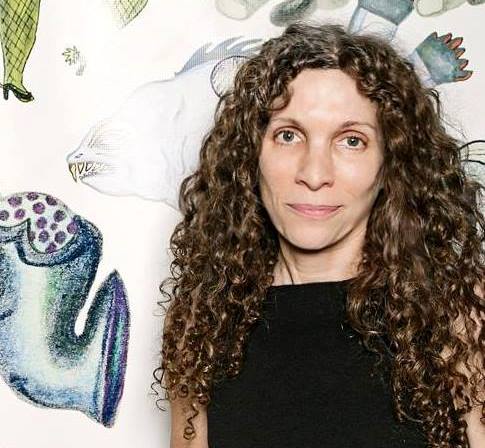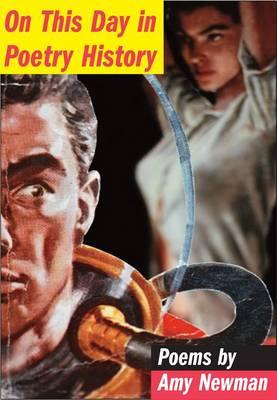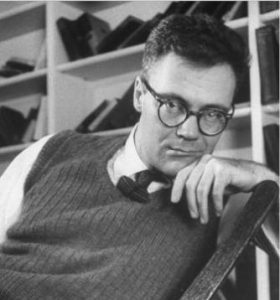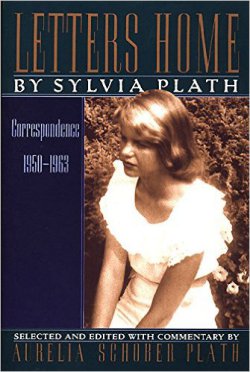 If Amy Newman’s On This Day in Poetry History is topping your must-read list, you’re certainly not alone. Poetry lovers here at EPL have been clamoring for a copy since the summer, and demand for her follow-up to Dear Editor only continues to grow. Described as a “dazzling new collection” by the NY Times, On This Day in Poetry History finds Newman exploring the lives of poetry heavyweights such as Sylvia Plath, Robert Lowell, Elizabeth Bishop, and John Berryman in search of that elusive “moment when a person becomes a poet.” A wholly innovative mix of biography and stunning verse, Newman’s latest showcases what Image praised as her “true mastery [of the] ability to play with language.” We recently spoke with the Northern Illinois University professor via email about rediscovering poetry in Manhattan, the history and allure of the “Confessional” poets, the challenges of biographical poetry, and how her favorite poem from the book came into being.
If Amy Newman’s On This Day in Poetry History is topping your must-read list, you’re certainly not alone. Poetry lovers here at EPL have been clamoring for a copy since the summer, and demand for her follow-up to Dear Editor only continues to grow. Described as a “dazzling new collection” by the NY Times, On This Day in Poetry History finds Newman exploring the lives of poetry heavyweights such as Sylvia Plath, Robert Lowell, Elizabeth Bishop, and John Berryman in search of that elusive “moment when a person becomes a poet.” A wholly innovative mix of biography and stunning verse, Newman’s latest showcases what Image praised as her “true mastery [of the] ability to play with language.” We recently spoke with the Northern Illinois University professor via email about rediscovering poetry in Manhattan, the history and allure of the “Confessional” poets, the challenges of biographical poetry, and how her favorite poem from the book came into being.
Evanston Public Library: Can you tell us a little about your background as a poet? What started you writing poetry? Has your idea of what poetry is changed since you began writing?
Amy Newman: I’ve always written poetry, since I was a kid, but I didn’t take myself seriously. In fact, I had already graduated from college and was working in Manhattan as a stylist for television commercials, which is a dynamic, exciting, stressful job that I didn’t love.
One morning I was readying all the materials in the studio, surrounded by people bustling about, by shopping bags full of items to collate and try on the talent. On the coffee table I noticed an issue of the The New Yorker, opened it and turned to “In Passing,” a poem by Stanley Plumly. I had studied poetry in college, and I had thought all of that —reading and drafting poetry—was behind me. But as I read the poem, the studio, the bustling, the feverish atmosphere, all fell away. After I read the final line, I looked up from the poem again, and I was surprised to be back in that studio. I felt so moved that I decided to go back to college to study.
My idea of poetry has changed since I began writing. Poetry is always changing—and also I have changed. I’ve been happy to see this mutability reflected in other poets too. Auden, for example, felt at one time that Wordsworth was the master and then later said that Eliot was the poet one must follow. And then he changed his mind about that, too. Poetry reflects the world, and as the world changes, poetry has to as well.
 EPL: In a recent interview with Arts + Literature Laboratory, you shared how On This Day in Poetry History grew from your interest in discovering what makes a poet a poet. Have you come to any conclusions? Is it possible to pinpoint “the moment in a person’s life when he or she becomes a poet?”
EPL: In a recent interview with Arts + Literature Laboratory, you shared how On This Day in Poetry History grew from your interest in discovering what makes a poet a poet. Have you come to any conclusions? Is it possible to pinpoint “the moment in a person’s life when he or she becomes a poet?”
AN: I wish! That would have been a great poem to write.
My interest in that moment when a person becomes a poet had grown out of my previous collection of poetry that itself had begun where I decided to try to figure out what makes a poem a poem. It’s not just line breaks that give a poem its life. There’s something in poetry that immediately differentiates it from not-poetry, a kind of energy, what R. P. Blackmur calls its “animating presence.” My search to isolate what makes a poem a poem became Dear Editor, a book of cover letters to an imaginary editor in which the letter-writer is unable or unwilling to move from the wandering, wondering mind that writes poetry to the rather standard mind that composes generic submission letters.
In the case of On This Day in Poetry History, although I wasn’t able to pinpoint that moment, I did discover something that to me seemed equally wonderful. In a way we deify these artists we admire, yet these mythic creatures were actual people living actual lives, and I was gratified by that realization that anyone, living as regular a life as we live, has the potential to create compelling and wonderful work. One needn’t be a mythic creature to write a beautiful poem.
EPL: How did you settle on which poets to include in the book? Is there something specific about the “Confessional” poets that helps illuminate the mysterious origins of American poetry? Is there a particular poet among the seven that you find especially intriguing or inspiring?
AN: I was doing research on the poetic response to T. S. Eliot for a class I was planning to teach, and I was especially interested in how the American poets—those often grouped together under the label “Confessional”—rebelled against Eliot’s influence and his theory of the impersonal in poetry, and “violated,” as Diane Middlebrook has written, “the norms of decorum for subject matter prevailing in serious literature.” It wasn’t so much an intentional violation as an exploration, a response to their world. Deviating from Eliot’s theory that poetry is “not a turning loose of emotion, but an escape from emotion; it is not the expression of personality, but an escape from personality,” they found the troubling aspects of their lives–their manic behaviors (what Lowell called his “pathological enthusiasms”), their past, their parents, the pressure to exist—to be material for poetry, and this was disruptive but also of its time. Such “confessionalism” grows out of a long tradition, though it wasn’t seen that way at first. The term “confessional,” for example, might be understood as spiritual autobiography, in the shadow of St. Augustine’s Confessions, a working through one’s life and one’s guilt, to find restoration, if such a thing exists.

And it was an interesting time as well: the high water mark for psychoanalysis combined with the high-water mark for psychopharmacology. Therapists prescribed so many medications in the pursuit of happiness, the drive for what one critic called the “dream of well-being.” These poets were afflicted, and they suffered their afflictions, but they created, as well, some of the best poetry of the century. So there was, on my part, a desire to excavate their lives as they lived, to study these people becoming poets. I thought if I read their lives through, I might find the place where Lowell, say, becomes Lowell. At a certain point in his biography, for example, he purposely lets his glasses fall out of the window and watches them descend. I felt, imagining that moment again, that I could understand, could see him seeking something. I felt moved to write about it.
And in response to the third part of this question: I don’t know if I find one poet particularly inspiring more than another, or maybe it’s more accurate to say I find each differently inspiring, for different reasons. The way each poet explores and shapes his or her materials—each way is different and beautiful. I find how they navigated their lives noble, how they responded to their time. Bishop is terribly interesting to me. She’s restrained throughout, and she remains, at the end of the book, still alive. I was happy to see her there.
EPL: Can you tell us about your research for the collection? How did you identify which biographical details to use? What were your challenges in combining biography and poetry?
AN: When I conceived of the project finally—to study and write about the lives of the poets to see if I could discover the moments they were becoming poets—I wanted to read everything available, everything I possibly could, all of Anne Sexton, all of John Berryman, all of Theodore Roethke that I could get into my hands. I love this kind of research anyway, cross-referencing, say, Sylvia Plath’s letters to her mother in Letters Home with the entries in her journal from that same time period, reading the correspondence between Lowell and Bishop and their biographies as well as other books about them. I was looking for moments that compelled me to write about each poet, a detail, large or small, that felt like life. It could be something seemingly small like toddler Elizabeth Bishop fascinated by a stocking in the grass in her yard, or it could be seemingly large as when Bishop crosses the equator in a ship bound for Brazil to a new kind of life for her. Both of these moments grew dimensional for me when I came upon them.
 At some point I realized that there were correspondences. I saw an imaginary Google Map with Plath doing something over here while Lowell did something over there in the same month or even the same week. At the same time Sexton is looking out of the window with her children, waiting for Santa Claus, Lowell is dropping William Carlos Williams off at a train station. Berryman is driving through a rainstorm in Minnesota while Plath prepares Court Green for her mother’s visit by painting hearts on the door to her bedroom. It seemed marvelous, these poets experiencing their lives in a kind of parallelism.
At some point I realized that there were correspondences. I saw an imaginary Google Map with Plath doing something over here while Lowell did something over there in the same month or even the same week. At the same time Sexton is looking out of the window with her children, waiting for Santa Claus, Lowell is dropping William Carlos Williams off at a train station. Berryman is driving through a rainstorm in Minnesota while Plath prepares Court Green for her mother’s visit by painting hearts on the door to her bedroom. It seemed marvelous, these poets experiencing their lives in a kind of parallelism.
As for challenges, I wanted the work to be completely faithful to the lives of the poets I was studying. I decided that each title must be historically accurate. Yet I am imagining the moment, too, and writing poetry. Eavan Boland says poetry writing is a combination of instinct and error, and it’s difficult to be accurate and inventive at once, isn’t it? I wanted to be as neutral as possible in my invention, so that it was not only poetry but also biography. The most difficult challenge was in the drafting of the poems that come near the end the book. Though Bishop remains alive at the book’s close, Plath, Sexton, Berryman, Lowell, Roethke, and Delmore Schwartz do not. Having such reverence for these people, I felt a great responsibility to treat these moments with accuracy and respect.
EPL: Do you have a favorite poem from the collection? Can you tell us a bit about how it came into being?
AN: I’m fond of “While Sylvia Plath Studies The Joy of Cooking on Her Honeymoon in Benidorm, Spain, Delmore Schwartz Reclines in the Front Seat of His Buick Roadmaster.” I can try to talk a little about how it came to be. During my research I’d encounter moments or details that felt both ordinary and extraordinary, as every detail of our lives can be. I noted, for example, that Sylvia Plath took the Joy of Cooking, Irma Rombauer’s iconic 1936 cookbook, on her honeymoon to Spain! That absorbed me. And later I would find among Delmore Schwartz’s notes that, having moved to a farm in New Jersey and feeling the effects of a tragically declining career, he consoled himself by listening to his beloved Giants on the radio at night, reclining in the front seat of his car. It was striking to think of Schwartz’s dying dream, scored by the radio’s game, against Plath skinning a rabbit for a stew, practicing the habits of happiness for what she imagined would be a bright future. And these intense writers, one consulting her Joy of Cooking, one turning toward baseball for comfort, seemed to me so American somehow.
EPL: What are you reading now? Can you suggest any recent poetry books we shouldn’t miss?
AN: Among the books on my reading stack are these gems: The Book of Hulga by Rita Mae Reese; Seam by Tarfia Faizullah; Beautiful Girls by Melissa Lee-Houghton; When My Brother Was an Aztec by Natalie Diaz; Admit One by Martha Collins; Small Hands by Mona Arshi. They are all different recent books, but each is its own wonderful experience. Another book isn’t as recent, but since it isn’t as known as it should be, I want to mention: A Wiser, More Beautiful Death by Miklós Radnóti.
Interview by Russell
